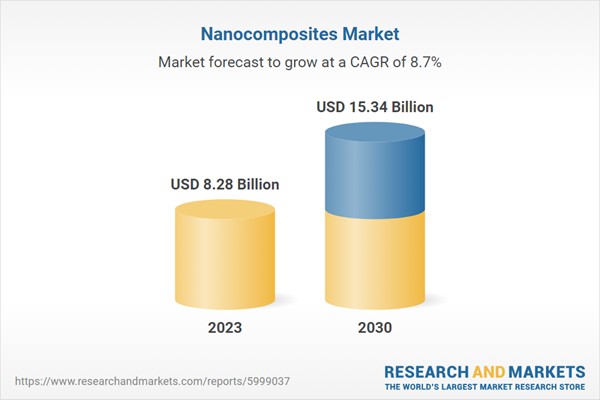Nanocomposites Market Growth & Trends
The global nanocomposites market size is expected to reach USD 15.34 billion by 2030, expanding at a CAGR of 8.7% from 2024 to 2030. Growing demand for nanocomposites in the automobile industry increased the application of nanocomposites in building and construction, high volume consumption in electronics and semiconductors are some of the major factors that have been driving the market. However, the high cost of materials and technology to manufacture them along with the environmental impact of certain materials used in nanocomposites manufacturing are holding back the market.Nanocomposites usually comprise of a strengthening layer/layers of various materials such as clay, plastics, glass, carbon nanotubes, graphene, and others. The binder material used is usually a polymeric resin (eg: epoxy) and this binding matrix holds the materials together to impart strength and higher toughness once the composite system has cured.
The nanocomposites market uses materials such as metals and metallic nanoparticles, polymers, nano-sized clay particles, carbon derivatives such as carbon nanotubes and graphene, and other nanoparticles. These materials can be sourced from raw material manufacturers in all the regions globally. Major raw material manufacturers have their manufacturing bases in Europe and North America and usually distribute their materials through local suppliers in various regions around the world.
Nanocomposites Market Report Highlights
- Metal/metal oxides are expected to register the fastest CAGR of 9.9% over the forecast period. Metal/metal oxides are extensively used in manufacturing electronic parts and semiconductors. Metal oxides exhibit superior electrical conductivity and are being used in the preparation of pseudo capacitive electrochemical supercapacitors. Metal oxides include the use of manganese, titanium, tantalum, and vanadium oxides in the manufacturing of electronic parts owing to high durability and its ability to withstand high temperature.
- Ceramic nanocomposites exhibit improved hardness, strength, durability, and as compared to their counterparts. Ceramic nanocomposites provide superior thermal resistance and are used extensively in aerospace applications. Furthermore, it is used in a variety of applications due to its characteristics including flame retardancy, high shock resistance, and improved magnetic and optical properties.
- Nanocomposites are used in the aviation industry in manufacturing flame retardant panels and high-performance components. In addition, it provides structural strength to the existing panels, which is expected to have a positive impact on market growth. Furthermore, nanocomposites easily blend with plastic and metal and provide added strength to panels.
- Europe is characterized by the growing demand for nanocomposites in automotive and aviation a-applications. Growing demand for these products owing to their lightweight and superior durability is expected to increase demand over the forecast period. Furthermore, these products are being increasingly used in the manufacturing of wind turbines and solar panels. In terms of product, nanoclay is expected to witness the fastest growth as compared to its counterparts.
- Key players in the nanocomposites market include Arkema SA, BASF SE, Cabot Corporation, Cyclics Corporation, DSM, Elementis Specialties Inc., eSPin Technologies Inc., DuPont, Foster Corporation, Powdermet Inc., Inframat Corporation, Zyvex Technologies.
Why should you buy this report?
- Comprehensive Market Analysis: Gain detailed insights into the global market across major regions and segments.
- Competitive Landscape: Explore the market presence of key players worldwide.
- Future Trends: Discover the pivotal trends and drivers shaping the future of the global market.
- Actionable Recommendations: Utilize insights to uncover new revenue streams and guide strategic business decisions.
This report addresses:
- Market intelligence to enable effective decision-making
- Market estimates and forecasts from 2018 to 2030
- Growth opportunities and trend analyses
- Segment and regional revenue forecasts for market assessment
- Competition strategy and market share analysis
- Product innovation listing for you to stay ahead of the curve
- COVID-19's impact and how to sustain in these fast-evolving markets
This product will be delivered within 1-3 business days.
Table of Contents
Chapter 1. Methodology and Scope
Chapter 2. Executive Summary
Chapter 3. Nanocomposites Market Variables, Trends, & Scope
Chapter 4. Nanocomposites Market: Product Estimates & Trend Analysis
Chapter 5. Nanocomposites Market: Application Estimates & Trend Analysis
Chapter 6. Nanocomposites Market: Regional Estimates & Trend Analysis
Chapter 7. Competitive Landscape
Companies Mentioned
- Cabot Corporation
- eSpin Technologies
- BASF SE
- Cyclics Corporation
- DSM
- Elementis Specialties Inc.
- Arkema SA
- DuPont
- Foster Corporation
- Powdermet Inc.
Methodology

LOADING...
Table Information
| Report Attribute | Details |
|---|---|
| No. of Pages | 100 |
| Published | August 2024 |
| Forecast Period | 2023 - 2030 |
| Estimated Market Value ( USD | $ 8.28 Billion |
| Forecasted Market Value ( USD | $ 15.34 Billion |
| Compound Annual Growth Rate | 8.7% |
| Regions Covered | Global |
| No. of Companies Mentioned | 10 |









